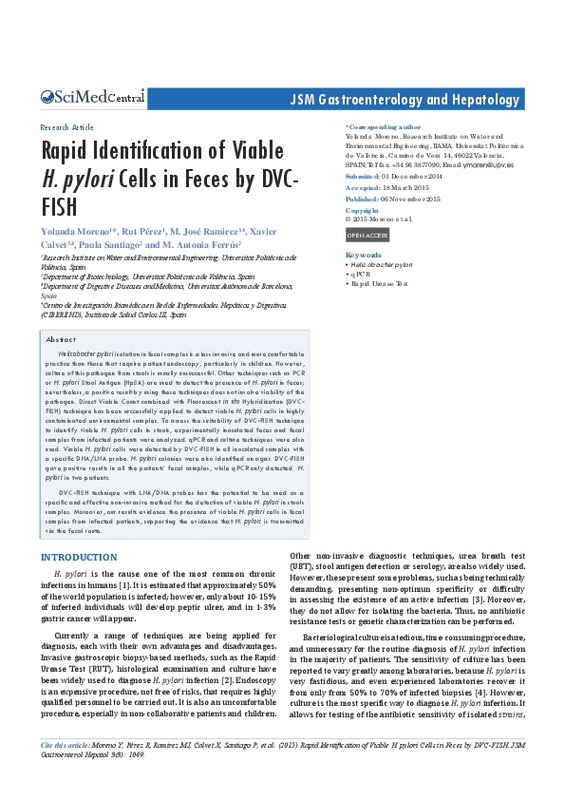JavaScript is disabled for your browser. Some features of this site may not work without it.
Buscar en RiuNet
Listar
Mi cuenta
Estadísticas
Ayuda RiuNet
Admin. UPV
Rapid Identification of Viable H. pylori Cells in Feces by DVCFISH
Mostrar el registro sencillo del ítem
Ficheros en el ítem
| dc.contributor.author | Moreno Trigos, Mª Yolanda
|
es_ES |
| dc.contributor.author | Pérez-Santonja, Rut
|
es_ES |
| dc.contributor.author | RAMIREZ, M.
|
es_ES |
| dc.contributor.author | Calvet, X.
|
es_ES |
| dc.contributor.author | Santiago Cuéllar, Paula
|
es_ES |
| dc.contributor.author | Ferrús Pérez, Mª Antonia
|
es_ES |
| dc.date.accessioned | 2018-02-14T15:14:58Z | |
| dc.date.available | 2018-02-14T15:14:58Z | |
| dc.date.issued | 2015 | es_ES |
| dc.identifier.uri | http://hdl.handle.net/10251/97911 | |
| dc.description.abstract | [EN] Helicobacter pylori isolation in fecal samples is a less invasive and more comfortable practice than those that require patient endoscopy, particularly in children. However, culture of this pathogen from stools is usually unsuccessful. Other techniques such as PCR or H. pylori Stool Antigen (HpSA) are used to detect the presence of H. pylori in feces; nevertheless, a positive result by using these techniques does not involve viability of the pathogen. Direct Viable Count combined with Fluorescent in situ Hybridization (DVC-FISH) technique has been successfully applied to detect viable H. pylori cells in highly contaminated environmental samples. To assess the suitability of DVC-FISH technique to identify viable H. pylori cells in stools, experimentally inoculated feces and fecal samples from infected patients were analyzed. qPCR and culture techniques were also used. Viable H. pylori cells were detected by DVC-FISH in all inoculated samples with a specific DNA/LNA probe. H. pylori colonies were also identified on agar. DVC-FISH gave positive results in all the patients' fecal samples, while qPCR only detected H. pylori in two patients. DVC-FISH technique with LNA/DNA probes has the potential to be used as a specific and effective non-invasive method for the detection of viable H. pylori in stools samples. Moreover, our results evidence the presence of viable H. pylori cells in fecal samples from infected patients, supporting the evidence that H. pylori is transmitted via the fecal route. | es_ES |
| dc.description.sponsorship | The work has been funded by AGL2014-53875-R grant (Ministerio de Economía y Competitividad, Spain). | |
| dc.language | Inglés | es_ES |
| dc.publisher | JSciMed Central | es_ES |
| dc.relation.ispartof | JSM Gastroenterology and Hepatology | es_ES |
| dc.rights | Reconocimiento (by) | es_ES |
| dc.subject.classification | MICROBIOLOGIA | es_ES |
| dc.title | Rapid Identification of Viable H. pylori Cells in Feces by DVCFISH | es_ES |
| dc.type | Artículo | es_ES |
| dc.relation.projectID | info:eu-repo/grantAgreement/MINECO//AGL2014-53875-R/ES/H. PYLORI Y OTROS HELICOBACTERS PATOGENOS EN AGUAS Y ALIMENTOS: DESARROLLO Y APLICACION DE HERRAMIENTAS MOLECULARES DIRIGIDAS A LA EVALUACION DEL RIESGO PARA EL CONSUMIDOR/ | es_ES |
| dc.rights.accessRights | Abierto | es_ES |
| dc.contributor.affiliation | Universitat Politècnica de València. Departamento de Biotecnología - Departament de Biotecnologia | es_ES |
| dc.contributor.affiliation | Universitat Politècnica de València. Instituto Universitario de Ingeniería del Agua y del Medio Ambiente - Institut Universitari d'Enginyeria de l'Aigua i Medi Ambient | es_ES |
| dc.description.bibliographicCitation | Moreno Trigos, MY.; Pérez-Santonja, R.; Ramirez, M.; Calvet, X.; Santiago Cuellar, P.; Ferrús Pérez, MA. (2015). Rapid Identification of Viable H. pylori Cells in Feces by DVCFISH. JSM Gastroenterology and Hepatology. 3(3). http://hdl.handle.net/10251/97911 | es_ES |
| dc.description.accrualMethod | S | es_ES |
| dc.relation.publisherversion | https://www.jscimedcentral.com/Gastroenterology/ | es_ES |
| dc.type.version | info:eu-repo/semantics/publishedVersion | es_ES |
| dc.description.volume | 3 | es_ES |
| dc.description.issue | 3 | es_ES |
| dc.identifier.eissn | 2373-9487 | es_ES |
| dc.relation.pasarela | S\326534 | es_ES |
| dc.contributor.funder | Ministerio de Economía, Industria y Competitividad | es_ES |






